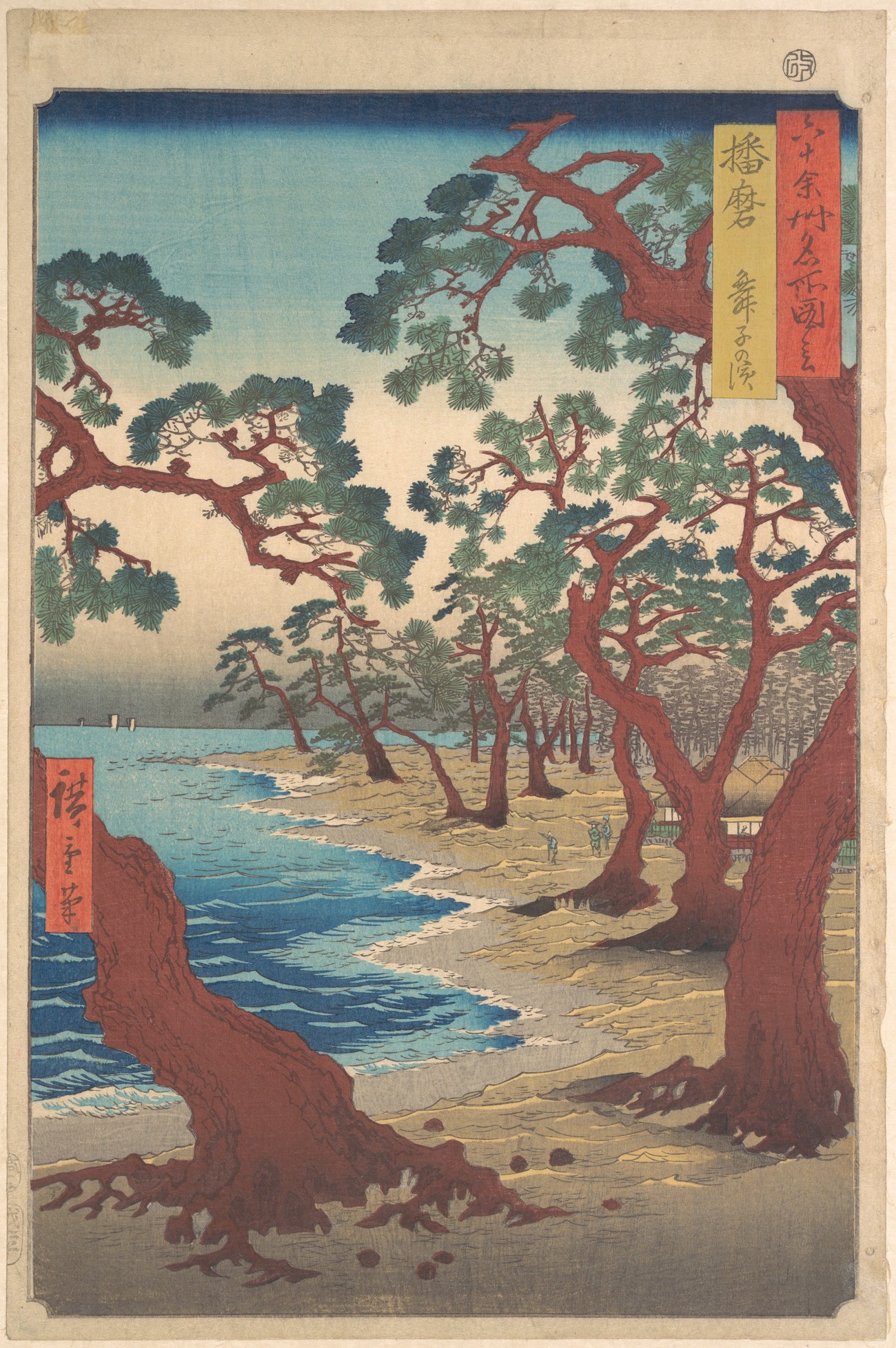-
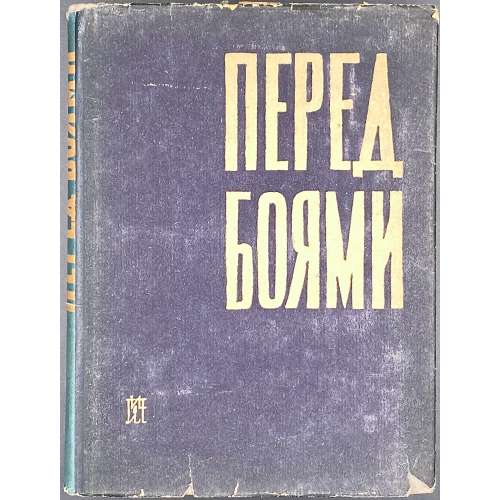 Sergei Petrovich Varshavsky [Сергей Петрович Варшавский] (Jewish-Russian, 1906 – 1980): «Цусима» (Tsushima) [対馬沖海戦], pp. 89-132. Description: Propaganda collection of short stories, hardcover, collated 8vo, [1]-158, 18 x 13 cm, bound in grey cloth with blind stamped lettering to front and blue lettering to spine, pp.: [1-4] 5-239 [240], dark blue dust jacket lettered to front, rear and spine. Title-page (red and black): ПЕРЕД БОЯМИ | ХУДОЖЕСТВЕННАЯ ЛИТЕРАТУРА НА ОБОРОНЕ СССР | СБОРНИК СТАТЕЙ | ПОД РЕД. Н. СВИРИНА. | Издательство писателей в Ленинграде || Print run: 5,500 copies.
Sergei Petrovich Varshavsky [Сергей Петрович Варшавский] (Jewish-Russian, 1906 – 1980): «Цусима» (Tsushima) [対馬沖海戦], pp. 89-132. Description: Propaganda collection of short stories, hardcover, collated 8vo, [1]-158, 18 x 13 cm, bound in grey cloth with blind stamped lettering to front and blue lettering to spine, pp.: [1-4] 5-239 [240], dark blue dust jacket lettered to front, rear and spine. Title-page (red and black): ПЕРЕД БОЯМИ | ХУДОЖЕСТВЕННАЯ ЛИТЕРАТУРА НА ОБОРОНЕ СССР | СБОРНИК СТАТЕЙ | ПОД РЕД. Н. СВИРИНА. | Издательство писателей в Ленинграде || Print run: 5,500 copies. -
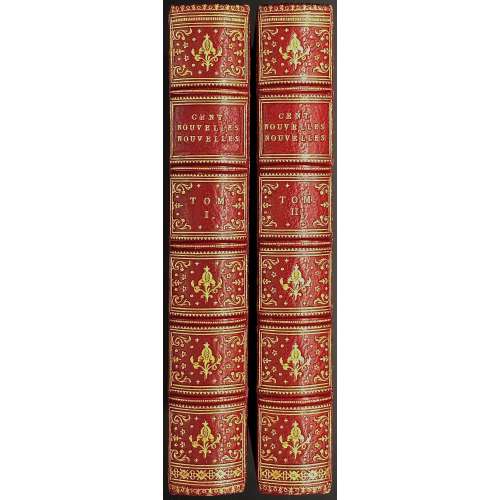 Description: Two volumes, 16.5 x 11 cm, collated 8vo, uniformly bound in the mid-19th century by H. Stamper (stamp to verso free endpaper) in red Morocco, ornated with gilt fillets and dentelles to boards and turn-ins, spine with raised bands and gilt decorations and lettering in compartments, marbled endpapers, all edges gilt; printed on laid paper; bookplate to front pastedown “EX LIBRIS | DANIEL | BERDITCHEVSKY”. Title-page (red and black, tall ‘s’): LES CENT | NOUVELLES | NOUVELLES. | SUIVENT LES CENT NOUVELLES | CONTENANT | Les Cent Histoires Nouveaux, | Qui sont moult plaisans a raconter, | En toutes bonnes Compagnies, | Par MANIERE DE JOYEUSETÉ. | Avec d'excellentes Figures en Taille-douce, | Gravées sur les desseins du fameux Mr. | ROMAIN DE HOOGE | & retouchées par feu | B. PICART LE ROMAIN | TOME PREMIER (TOME SECOND) |{device} | A COLOGNE | Chez Pierre Gaillard. | M.DCCXXXVI. || Vol. 1: Collation: [1] flyleaf torn out, [1] frontispiece, [1] title-page, [3] preface (*2-4), [1] Auertissement, [10] table (2+**-**8), A-Bb8 (Bb8 blank); 45 in-text half-page copperplate etchings by various engravers after Romain de Hooge; total 215 leaves plus ffl and frontispiece by Gilliam van der Gouwen after Romain de Hooge. Pagination (starting from t.p.): [30] 1-397 [398] [2], total 430 pages. Vol. 2: Collation: ffl, [*1] t.p., [11] table (*2-8, **-4), A-Aa8 Bb4 (Bb4 blank); 55 in-text half-page copperplate etchings by various engravers after Romain de Hooge; total 208 leaves plus ffl. Pagination: [24] 1-389 [390] [2], total 416 pages. Catalogue raisonné: Landwehr (1970) № 94, p. 203; Lewine (1898) p. 326; Cohen-DeRicci (1912) p. 658. Landwehr cites two editions after the 1st of 1701: Amsterdam 1732 and Cologne 1786 [i.e. 1736]. Both Lewine and Cohen-DeRicci attribute the text to Louis XI and mention the 1736 reprint (though not 1786). The first edition of “Les cent nouvelles nouvelles” appeared in 1486 by commission of Duke of Burgundy Philippe le Bon; the text is attributed to Philippe Pot (1428 – 1493), Antoine de La Sale (c. 1385 – c. 1460) or King Louis XI (1423 – 1483). Contributors: Artists: Romain de Hooge (Dutch, 1645 – 1708) Bernard Picart (French, 1673 – 1733) Engravers: Gilliam van der Gouwen (Dutch, c. 1657 – 1716) (frontispiece) Laurens Scherm (Dutch, fl. 1689 – 1701) (nouvelles XXIX, XXX, LXXVII) Jan Van Vianen (Dutch, c.1660 – 1726?) (nouvelles L, LII, LVII-LX, LXIV-LXVII, LXX) Binder: Henry Stamper (British, 1802? – 1887) Commissioner: Philippe le Bon [Philip III] (French, 1396 – 1467) Publisher: Pierre Gaillard (French, fl. 1715 – 1737)
Description: Two volumes, 16.5 x 11 cm, collated 8vo, uniformly bound in the mid-19th century by H. Stamper (stamp to verso free endpaper) in red Morocco, ornated with gilt fillets and dentelles to boards and turn-ins, spine with raised bands and gilt decorations and lettering in compartments, marbled endpapers, all edges gilt; printed on laid paper; bookplate to front pastedown “EX LIBRIS | DANIEL | BERDITCHEVSKY”. Title-page (red and black, tall ‘s’): LES CENT | NOUVELLES | NOUVELLES. | SUIVENT LES CENT NOUVELLES | CONTENANT | Les Cent Histoires Nouveaux, | Qui sont moult plaisans a raconter, | En toutes bonnes Compagnies, | Par MANIERE DE JOYEUSETÉ. | Avec d'excellentes Figures en Taille-douce, | Gravées sur les desseins du fameux Mr. | ROMAIN DE HOOGE | & retouchées par feu | B. PICART LE ROMAIN | TOME PREMIER (TOME SECOND) |{device} | A COLOGNE | Chez Pierre Gaillard. | M.DCCXXXVI. || Vol. 1: Collation: [1] flyleaf torn out, [1] frontispiece, [1] title-page, [3] preface (*2-4), [1] Auertissement, [10] table (2+**-**8), A-Bb8 (Bb8 blank); 45 in-text half-page copperplate etchings by various engravers after Romain de Hooge; total 215 leaves plus ffl and frontispiece by Gilliam van der Gouwen after Romain de Hooge. Pagination (starting from t.p.): [30] 1-397 [398] [2], total 430 pages. Vol. 2: Collation: ffl, [*1] t.p., [11] table (*2-8, **-4), A-Aa8 Bb4 (Bb4 blank); 55 in-text half-page copperplate etchings by various engravers after Romain de Hooge; total 208 leaves plus ffl. Pagination: [24] 1-389 [390] [2], total 416 pages. Catalogue raisonné: Landwehr (1970) № 94, p. 203; Lewine (1898) p. 326; Cohen-DeRicci (1912) p. 658. Landwehr cites two editions after the 1st of 1701: Amsterdam 1732 and Cologne 1786 [i.e. 1736]. Both Lewine and Cohen-DeRicci attribute the text to Louis XI and mention the 1736 reprint (though not 1786). The first edition of “Les cent nouvelles nouvelles” appeared in 1486 by commission of Duke of Burgundy Philippe le Bon; the text is attributed to Philippe Pot (1428 – 1493), Antoine de La Sale (c. 1385 – c. 1460) or King Louis XI (1423 – 1483). Contributors: Artists: Romain de Hooge (Dutch, 1645 – 1708) Bernard Picart (French, 1673 – 1733) Engravers: Gilliam van der Gouwen (Dutch, c. 1657 – 1716) (frontispiece) Laurens Scherm (Dutch, fl. 1689 – 1701) (nouvelles XXIX, XXX, LXXVII) Jan Van Vianen (Dutch, c.1660 – 1726?) (nouvelles L, LII, LVII-LX, LXIV-LXVII, LXX) Binder: Henry Stamper (British, 1802? – 1887) Commissioner: Philippe le Bon [Philip III] (French, 1396 – 1467) Publisher: Pierre Gaillard (French, fl. 1715 – 1737) -
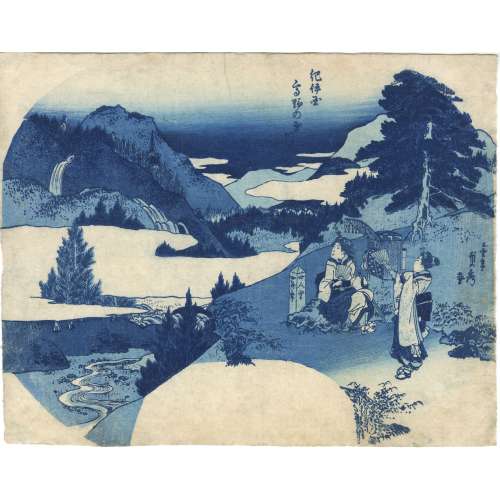 An uncut aizuri fan print showing two travellers admiring the view of the Tama River [多摩川] (Tamagawa) and Mount Kōya [高野山] (Kōyasan) in Kii Province [紀伊国] (Kii no Kuni). Artist: Utagawa Sadahide [歌川貞秀] (Japanese, 1807 – 1879). Signed: Gountei Sadahide ga [五雲亭貞秀画] (Picture by Gountei Sadahide). Publisher: Unknown. Published: c. 1849. No date seal, no censor seal (privately printed?) Media: Fan print [団扇絵] (uchiwa-e), 235 x 300 mm.
An uncut aizuri fan print showing two travellers admiring the view of the Tama River [多摩川] (Tamagawa) and Mount Kōya [高野山] (Kōyasan) in Kii Province [紀伊国] (Kii no Kuni). Artist: Utagawa Sadahide [歌川貞秀] (Japanese, 1807 – 1879). Signed: Gountei Sadahide ga [五雲亭貞秀画] (Picture by Gountei Sadahide). Publisher: Unknown. Published: c. 1849. No date seal, no censor seal (privately printed?) Media: Fan print [団扇絵] (uchiwa-e), 235 x 300 mm. -
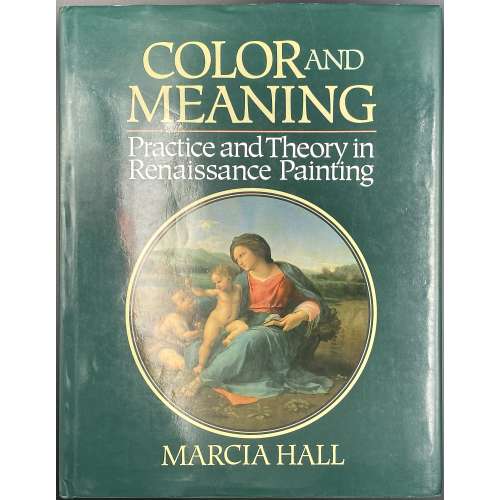 Hardcover, 28.8 x 22.3 cm, green cloth, gilt lettering to spine, pictorial dust jacket; pp.: [i-iv] v-xiv, 1-274, total 288 pp., ils. ISBN: 9780521392228, 9780521457330, 0521392225, 0521457335. Title-page: COLOR | AND | MEANING | Practice and Theory in Renaissance Painting | MARCIA B. HALL | CAMBRIDGE UNIVERSITY PRESS | Cambridge | New York Port Chester Melbourne Sydney || Marcia B. Hall (American, b. 1939)
Hardcover, 28.8 x 22.3 cm, green cloth, gilt lettering to spine, pictorial dust jacket; pp.: [i-iv] v-xiv, 1-274, total 288 pp., ils. ISBN: 9780521392228, 9780521457330, 0521392225, 0521457335. Title-page: COLOR | AND | MEANING | Practice and Theory in Renaissance Painting | MARCIA B. HALL | CAMBRIDGE UNIVERSITY PRESS | Cambridge | New York Port Chester Melbourne Sydney || Marcia B. Hall (American, b. 1939) -
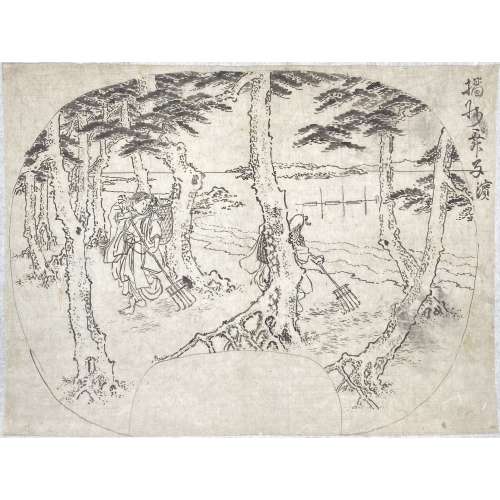 Artist: Veronica Miller attributes the drawing to Utagawa Sadahide [歌川 貞秀] (Japanese, 1807 – 1879), also known as Gountei Sadahide [五雲亭 貞秀]. A preparatory drawing for a fan print depicts two women raking pine needles along the scenic beach at Harima. Inscription at top right "Maiko Beach in Harima" (Harima Maiko no Hama) [播磨 舞子濱], which is now located in Hyōgo Prefecture. The view must be of the Akashi Strait, looking towards Awaji Island. Drawn on thin hanshita paper, mounted lightly at the top to a backing paper, but unbacked. Size: 240 x 319 mm. Attribution to Sadahide based on his design titled "Suma Bay: Matsukaze and Murasame" (see below):
Artist: Veronica Miller attributes the drawing to Utagawa Sadahide [歌川 貞秀] (Japanese, 1807 – 1879), also known as Gountei Sadahide [五雲亭 貞秀]. A preparatory drawing for a fan print depicts two women raking pine needles along the scenic beach at Harima. Inscription at top right "Maiko Beach in Harima" (Harima Maiko no Hama) [播磨 舞子濱], which is now located in Hyōgo Prefecture. The view must be of the Akashi Strait, looking towards Awaji Island. Drawn on thin hanshita paper, mounted lightly at the top to a backing paper, but unbacked. Size: 240 x 319 mm. Attribution to Sadahide based on his design titled "Suma Bay: Matsukaze and Murasame" (see below):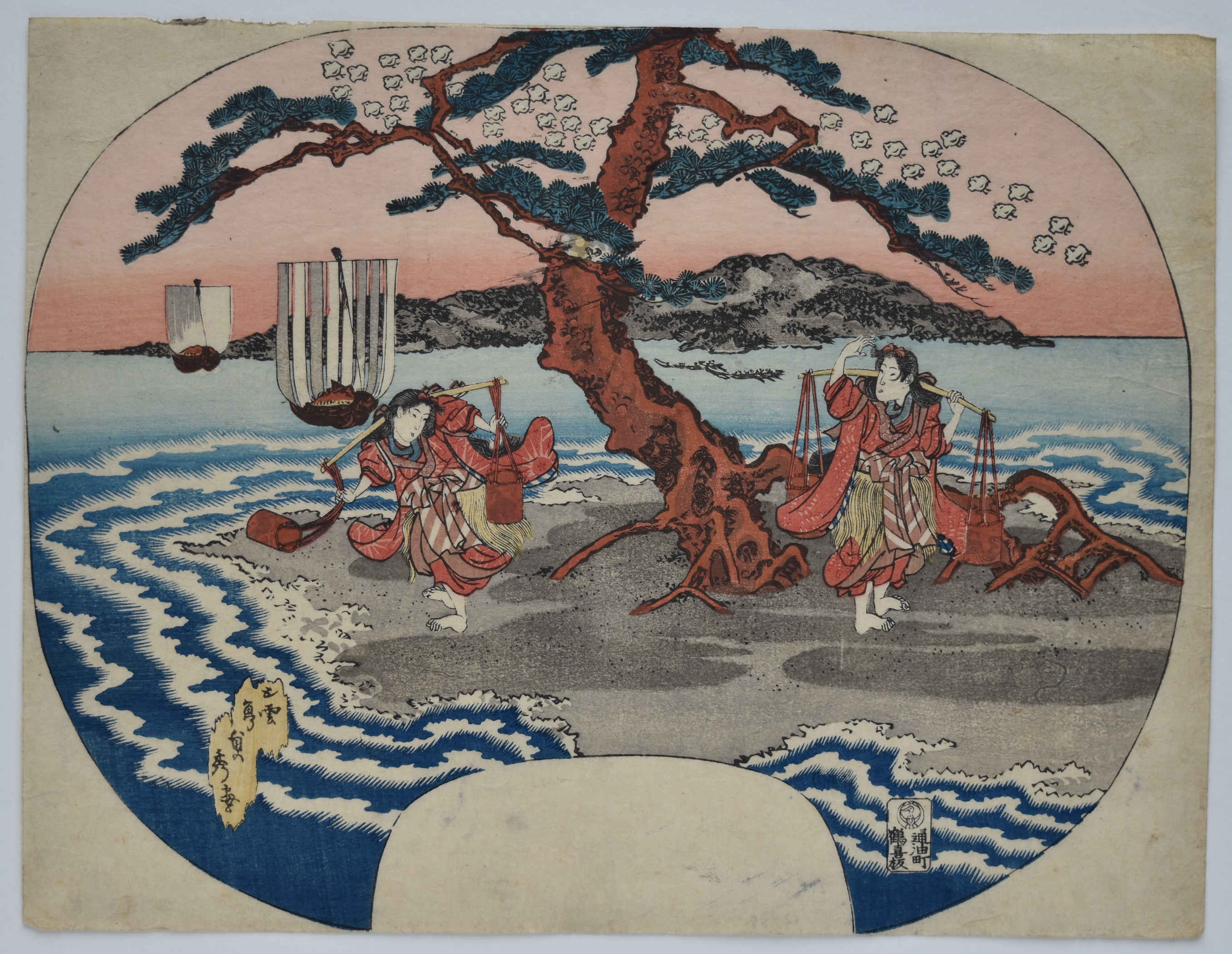 See also Maiko Beach, Harima Province, from the series Views of Famous Places in the Sixty-Odd Provinces,
See also Maiko Beach, Harima Province, from the series Views of Famous Places in the Sixty-Odd Provinces,
-
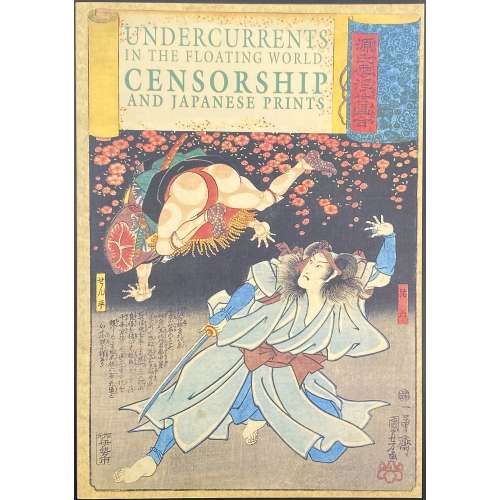 Paperback, 27.5 x 19 cm, pictorial wrappers, lettering to front wrapper and spine, pp.: [i-iv] v-viii, 1-104, ils.: 50 figures; catalogue, notes, and bibliography. Title-page: UNDERCURRENTS | IN THE FLOATING WORLD: | CENSORSHIP | AND JAPANESE PRINTS | Sarah E. Thompson | H. D. Harootunian | {kiwame seal} | THE ASIA SOCIETY GALLERIES | NEW YORK || Exhibition in NY: October 9, 1991 – January 5, 1992. Authors: Sarah E. Thompson (American, b. 1951) Harry D. Harootunian (Armenian-American, b. 1929)
Paperback, 27.5 x 19 cm, pictorial wrappers, lettering to front wrapper and spine, pp.: [i-iv] v-viii, 1-104, ils.: 50 figures; catalogue, notes, and bibliography. Title-page: UNDERCURRENTS | IN THE FLOATING WORLD: | CENSORSHIP | AND JAPANESE PRINTS | Sarah E. Thompson | H. D. Harootunian | {kiwame seal} | THE ASIA SOCIETY GALLERIES | NEW YORK || Exhibition in NY: October 9, 1991 – January 5, 1992. Authors: Sarah E. Thompson (American, b. 1951) Harry D. Harootunian (Armenian-American, b. 1929) -
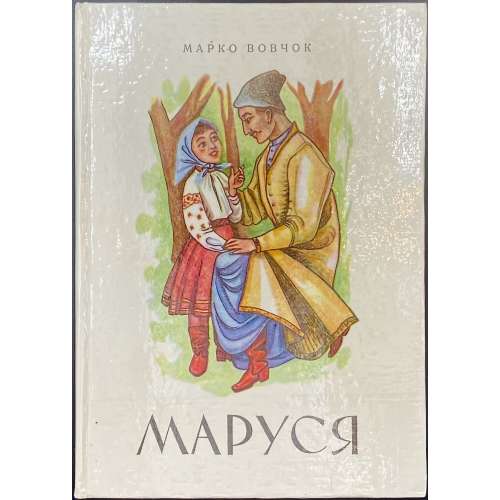 Hardcover, 20.7 x 14.7 cm, pictorial glossy paper over cardboard, vignettes and lettering to front and back covers, pp. [1-2] 3-140 [4]; collated 8vo: 1-98, total 72 leaves. Five full-page plates and numerous tailpieces after woodcuts by Myron Levytsky. This is a translation from the French version of Pierre-Jules Hetzel into Ukrainian, published in Toronto and New York in 1971: Марко Вовчок. Маруся. Повiсть. З французского видання П.-Ж. Сталя. — Торонто, Нью-Йорк: Бiблiотека молодi, 1971. Vignettes to the covers and other design elements are by Л. Гринiв. Title-page: МАРКО ВОВЧОК | МАРУСЯ | ПОВIСТЬ | Львів | “Поклик сумління” | 1993 || Contributors: Марко Вовчок [Marko Vovchok; Марія Олександрівна Вілінська] (Ukrainian, 1833 – 1907) – author. Іван Овксентійович Денисюк (Ukrainin, 1924 – 2009) – author/foreword. Мирон Миколайович Левицький [Myron Levytsky] (Ukrainin-Canadian, 1913 – 1993) – artist. Pierre-Jules Hetzel [P.-J. Stahl] (French, 1814 – 1886) – author. The French version of the Ukrainian name Маруся —> MAROUSSIA. The French version of the book: LIB-2674.2021; other copies of the Ukrainian edition (1943): LIB-3136.2023, LIB-3137.2023 (1959) and LIB-3170.2023 – all translated from the Russian by Vasyl Domanytskyi [Василь Миколайович Доманицький, Василий Николаевич Доманицкий] (Ukrainian, 1877 – 1910). Other variants of the name Марко Вовчок: Markowovzok and Marko Vovtchok.
Hardcover, 20.7 x 14.7 cm, pictorial glossy paper over cardboard, vignettes and lettering to front and back covers, pp. [1-2] 3-140 [4]; collated 8vo: 1-98, total 72 leaves. Five full-page plates and numerous tailpieces after woodcuts by Myron Levytsky. This is a translation from the French version of Pierre-Jules Hetzel into Ukrainian, published in Toronto and New York in 1971: Марко Вовчок. Маруся. Повiсть. З французского видання П.-Ж. Сталя. — Торонто, Нью-Йорк: Бiблiотека молодi, 1971. Vignettes to the covers and other design elements are by Л. Гринiв. Title-page: МАРКО ВОВЧОК | МАРУСЯ | ПОВIСТЬ | Львів | “Поклик сумління” | 1993 || Contributors: Марко Вовчок [Marko Vovchok; Марія Олександрівна Вілінська] (Ukrainian, 1833 – 1907) – author. Іван Овксентійович Денисюк (Ukrainin, 1924 – 2009) – author/foreword. Мирон Миколайович Левицький [Myron Levytsky] (Ukrainin-Canadian, 1913 – 1993) – artist. Pierre-Jules Hetzel [P.-J. Stahl] (French, 1814 – 1886) – author. The French version of the Ukrainian name Маруся —> MAROUSSIA. The French version of the book: LIB-2674.2021; other copies of the Ukrainian edition (1943): LIB-3136.2023, LIB-3137.2023 (1959) and LIB-3170.2023 – all translated from the Russian by Vasyl Domanytskyi [Василь Миколайович Доманицький, Василий Николаевич Доманицкий] (Ukrainian, 1877 – 1910). Other variants of the name Марко Вовчок: Markowovzok and Marko Vovtchok. -
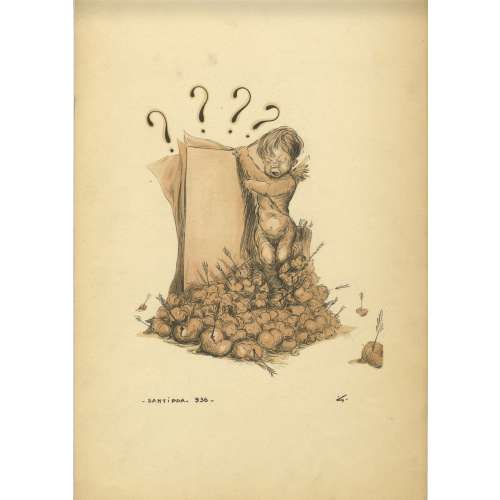 Publisher's flapped folder of black velvet paper with dark green embossed vignette, 494 x 325 mm, with a pink limitation label inside the front cover and a printed spade with 'FIN" inside the back cover; a set of 13 lithographs signed Santippa, 936; 480 x 310 mm each, twelve in black and one (title) coloured with sanguine. Limited edition of 250 copies, 1-100 printed on Hollande and 150 on Japon; this is copy № 127.
Publisher's flapped folder of black velvet paper with dark green embossed vignette, 494 x 325 mm, with a pink limitation label inside the front cover and a printed spade with 'FIN" inside the back cover; a set of 13 lithographs signed Santippa, 936; 480 x 310 mm each, twelve in black and one (title) coloured with sanguine. Limited edition of 250 copies, 1-100 printed on Hollande and 150 on Japon; this is copy № 127.Titles: Rêverie, Gaspillage, Exagération, Simplicité, Gourmandise, Abondance, Violence, Fantaisie, Faiblesse, Curiosité, Obligeance, Surprise.
Contributors:Gaston Hoffmann [Santippa] (French, 1883 – 1977)
-
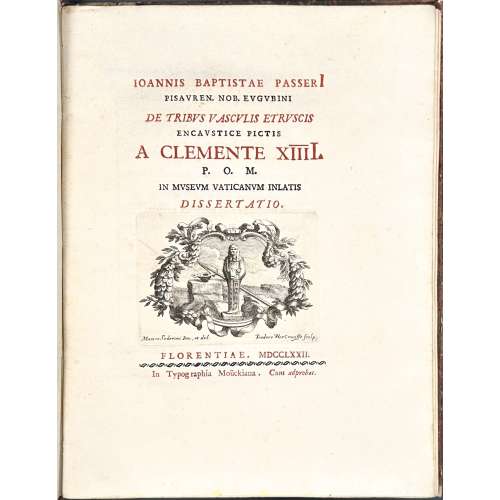 Owner’s wrappers, 28 x 21 cm, printed on laid paper, unpaginated, collated ffl, [A, B]4 C-G4, 2 ffl; total 28 leaves plus 5 engraved plates by Allegrini after Mariotti; engraved title-page (Vercruys after Soderini), head- and tailpieces (Gregori after del Moro) and initials. Owner's label to front pastedown: Marc Burdin, prêtre. Title-page (engraved, red and black): IOANNIS BAPTISTAE PASSERI | PISAUREN. NOB. EUGUBINI | DE TRIBUS VASCULIS ETRUSCIS | ENCAUSTICE PICTIS | A CLEMENTE XIIII. | P.O.M. | IN MUSEUM VATICANUM INLATIS | DISSERTATIO. | {VIGNETTE} | FLORENTIAE. MDCCLXXII. | ~ | in Typographia Moückiana. Cum adprobat. || Dedication: ANTIQVARIAE. ERVDITIONIS. PROPAGATORI EXIMIO ABSOLVTISSIMAM . HANC. DISSERTATIONEM CLARISS. PASSERII DE . IMAGINIBVS . ET . SYMBOLIS TRIVM . VASORVM . ETRVSCI . OPERIS QVAE PRINCIPIS. NOSTRI.SANCTISS. ET. SAPIENTISS. LARGITATE IN . VATICANVM . MVSEVM A. SE. CVMVLATISSIME . DITATVM INVE CTA . FVERVNT REGINALDVS.COMES.ANSIDAEVS.PATR.PERVS. M. A. CARD. PRONEPOS DEVOTVS. NOMINI . MAIESTATIQVE . EIVS DEMISSISSIME. Translation: "To the most excellent promoter of antiquities, the most accomplished: This most complete dissertation concerning the images and symbols of three Etruscan vases, which were most abundantly bestowed by our most holy and wise Prince onto the Vatican museum, was composed by the illustrious Passerius. Reginald, Count of Ansidius, true ancestral father, grandson by blood of the Cardinal, devoted most humbly and devoutly to his name and majesty." Note: P.O.M. stands for "Papa Optimo Maximo", which translates to "Father Most Excellent." For a similar vase in this collection, see VO-0098.
Owner’s wrappers, 28 x 21 cm, printed on laid paper, unpaginated, collated ffl, [A, B]4 C-G4, 2 ffl; total 28 leaves plus 5 engraved plates by Allegrini after Mariotti; engraved title-page (Vercruys after Soderini), head- and tailpieces (Gregori after del Moro) and initials. Owner's label to front pastedown: Marc Burdin, prêtre. Title-page (engraved, red and black): IOANNIS BAPTISTAE PASSERI | PISAUREN. NOB. EUGUBINI | DE TRIBUS VASCULIS ETRUSCIS | ENCAUSTICE PICTIS | A CLEMENTE XIIII. | P.O.M. | IN MUSEUM VATICANUM INLATIS | DISSERTATIO. | {VIGNETTE} | FLORENTIAE. MDCCLXXII. | ~ | in Typographia Moückiana. Cum adprobat. || Dedication: ANTIQVARIAE. ERVDITIONIS. PROPAGATORI EXIMIO ABSOLVTISSIMAM . HANC. DISSERTATIONEM CLARISS. PASSERII DE . IMAGINIBVS . ET . SYMBOLIS TRIVM . VASORVM . ETRVSCI . OPERIS QVAE PRINCIPIS. NOSTRI.SANCTISS. ET. SAPIENTISS. LARGITATE IN . VATICANVM . MVSEVM A. SE. CVMVLATISSIME . DITATVM INVE CTA . FVERVNT REGINALDVS.COMES.ANSIDAEVS.PATR.PERVS. M. A. CARD. PRONEPOS DEVOTVS. NOMINI . MAIESTATIQVE . EIVS DEMISSISSIME. Translation: "To the most excellent promoter of antiquities, the most accomplished: This most complete dissertation concerning the images and symbols of three Etruscan vases, which were most abundantly bestowed by our most holy and wise Prince onto the Vatican museum, was composed by the illustrious Passerius. Reginald, Count of Ansidius, true ancestral father, grandson by blood of the Cardinal, devoted most humbly and devoutly to his name and majesty." Note: P.O.M. stands for "Papa Optimo Maximo", which translates to "Father Most Excellent." For a similar vase in this collection, see VO-0098.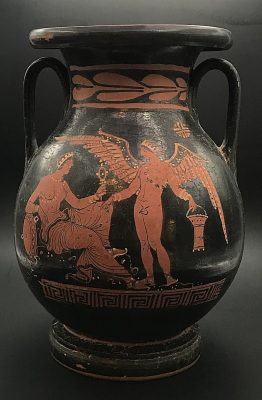
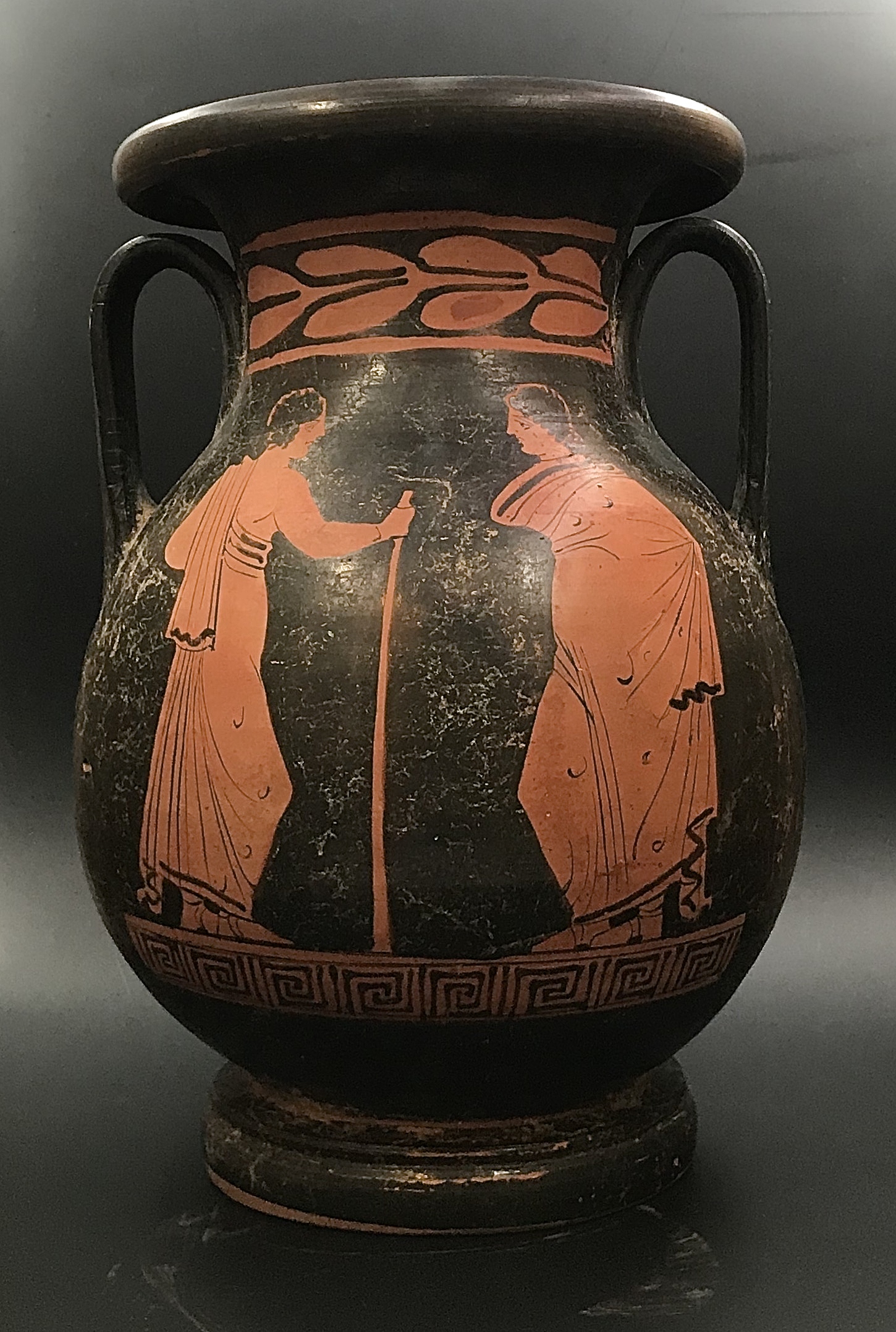 This vase is attributed to Apulia, ca. 330 BCE. Probably, Passeri was wrong in attributing this type of vessel to Etruscan vase painting, produced from the 7th through the 4th centuries BC.
Contributors:
Giovanni Battista Passeri (Italian, 1694 – 1780) – author.
Francesco Moücke (Italian, fl. 1729 – 1787) – publisher.
Pope Clement XIV [Ganganelli, Giovanni Vincenzo Antonio] (Italian, 1705 – 1774) – dedicatee.
Artists:
Mauro Soderini (Italian, 1704 – after 1751)
Carlo Spiridione Mariotti (Italian, 1726 – 1790)
Lorenzo del Moro (Italian, 1677 – 1735)
Engravers:
Theodor Vercruys [Teodoro Vercruysse] (Dutch, 1678 – 1739)
Francesco Allegrini da Gubbio (Italian, 1587 – 1663)
Carlo Bartolomeo Gregori (Italian, 1702 – 1759)
This vase is attributed to Apulia, ca. 330 BCE. Probably, Passeri was wrong in attributing this type of vessel to Etruscan vase painting, produced from the 7th through the 4th centuries BC.
Contributors:
Giovanni Battista Passeri (Italian, 1694 – 1780) – author.
Francesco Moücke (Italian, fl. 1729 – 1787) – publisher.
Pope Clement XIV [Ganganelli, Giovanni Vincenzo Antonio] (Italian, 1705 – 1774) – dedicatee.
Artists:
Mauro Soderini (Italian, 1704 – after 1751)
Carlo Spiridione Mariotti (Italian, 1726 – 1790)
Lorenzo del Moro (Italian, 1677 – 1735)
Engravers:
Theodor Vercruys [Teodoro Vercruysse] (Dutch, 1678 – 1739)
Francesco Allegrini da Gubbio (Italian, 1587 – 1663)
Carlo Bartolomeo Gregori (Italian, 1702 – 1759) -
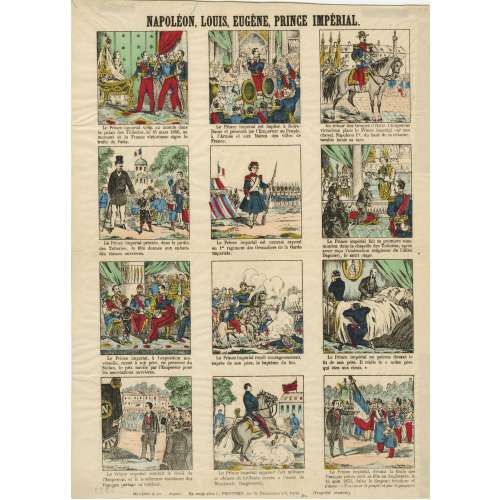 Another copy of SVFC-0745-3.2023, 395 x 290 mm; black ink stamp “5322” to reverse. Jean Charles Pellerin (French, 1756 – 1836)
Another copy of SVFC-0745-3.2023, 395 x 290 mm; black ink stamp “5322” to reverse. Jean Charles Pellerin (French, 1756 – 1836) -
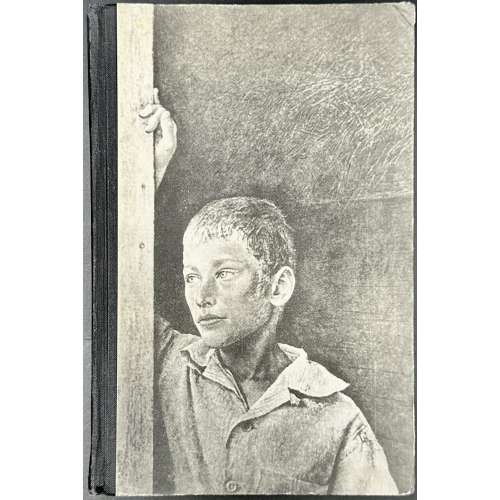 Hardcover, 22.2 x 14.6 cm, quarter black cloth, pictorial boards, lettering to spine; pp.: [2] 3-253 [3], collated 8vo: 1-168, total 128 leaves plus portrait frontispiece. Title-page: Дж. Д. СЭЛИНДЖЕР | ПОВЕСТИ | НАД ПРОПАСТЬЮ | ВО РЖИ | ВЫШЕ СТРОПИЛА, | ПЛОТНИКИ | РАССКАЗЫ | ХОРОШО ЛОВИТСЯ | РЫБКА-БАНАНКА | ЧЕЛОВЕК, КОТОРЫЙ | СМЕЯЛСЯ | ГОЛУБОЙ ПЕРИОД | ДЕ ДОМЬЕ-СМИТА | ЛАПА-РАСТЯПА | ПЕРЕВОД С АНГЛИЙСКОГО | И ПРЕДИСЛОВИЕ | Р. РАЙТ-КОВАЛЕВОЙ | ИЗДАТЕЛЬСТВО ЦК ВЛКСМ | «МОЛОДАЯ ГВАРДИЯ», 1965 || T.p. verso: […] J. D. Salinger | The Catcher in the Rye | Raise high the Roof Beam, Carpenters | A Perfect Day for Bananafish | The Laughing Man | De Daumier — Smith’s Blue Period | Uncle Wiggly in Connecticut | Художник Б. Жутовский | (В оформлении использован фрагмент картины | американского художника Э. Уайеса) || Print run: 115,000 copies. Contributors: [Джером Дэвид Сэлинджер] Jerome David Salinger (American, 1919 – 2010) Райт-Ковалёва, Рита [Черномордик, Раиса Яковлевна] (Russian, 1898 – 1988) Жутовский, Борис Иосифович (Russian, 1932 – 2023) «Э. Уайес» – [Эндрю Уайет] Andrew Wyeth (American, 1917 – 2009)
Hardcover, 22.2 x 14.6 cm, quarter black cloth, pictorial boards, lettering to spine; pp.: [2] 3-253 [3], collated 8vo: 1-168, total 128 leaves plus portrait frontispiece. Title-page: Дж. Д. СЭЛИНДЖЕР | ПОВЕСТИ | НАД ПРОПАСТЬЮ | ВО РЖИ | ВЫШЕ СТРОПИЛА, | ПЛОТНИКИ | РАССКАЗЫ | ХОРОШО ЛОВИТСЯ | РЫБКА-БАНАНКА | ЧЕЛОВЕК, КОТОРЫЙ | СМЕЯЛСЯ | ГОЛУБОЙ ПЕРИОД | ДЕ ДОМЬЕ-СМИТА | ЛАПА-РАСТЯПА | ПЕРЕВОД С АНГЛИЙСКОГО | И ПРЕДИСЛОВИЕ | Р. РАЙТ-КОВАЛЕВОЙ | ИЗДАТЕЛЬСТВО ЦК ВЛКСМ | «МОЛОДАЯ ГВАРДИЯ», 1965 || T.p. verso: […] J. D. Salinger | The Catcher in the Rye | Raise high the Roof Beam, Carpenters | A Perfect Day for Bananafish | The Laughing Man | De Daumier — Smith’s Blue Period | Uncle Wiggly in Connecticut | Художник Б. Жутовский | (В оформлении использован фрагмент картины | американского художника Э. Уайеса) || Print run: 115,000 copies. Contributors: [Джером Дэвид Сэлинджер] Jerome David Salinger (American, 1919 – 2010) Райт-Ковалёва, Рита [Черномордик, Раиса Яковлевна] (Russian, 1898 – 1988) Жутовский, Борис Иосифович (Russian, 1932 – 2023) «Э. Уайес» – [Эндрю Уайет] Andrew Wyeth (American, 1917 – 2009) -
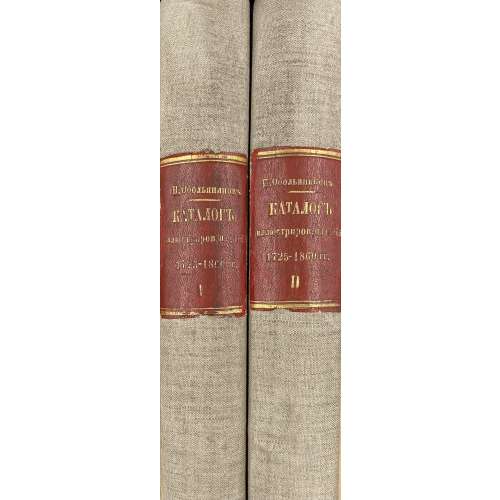 Two volumes, 32 x 24 cm each, uniformly bound in grey cloth with crimson morocco labels with gilt lettering to spine “Н. Обольяниновъ | КАТАЛОГЪ | иллюстриров. изданiй | 1725-1860 гг. | I (II)”, original wrappers preserved. To t.p. verso ink stamps “Latvijas PSR Zinātn̦u akadēmija Fundamentālā bibliotēka”, “1964”, “KATALOGS”, and “Z.A.B. Inv. № 80274”. Printed on laid paper, pagination throughout. 3,038 items with bibliographical descriptions. Title-page: КАТАЛОГЪ | РУССКИХЪ ИЛЛЮСТРИРОВАННЫХЪ | ИЗДАНIЙ | 1725—1860 гг. | — | СОСТАВИЛЪ | Н. Обольяниновъ. | Въ двухъ томахъ | Т. I (II). | ~ | МОСКВА – 1914 (1915). | Товарищество ТИПОГРАФIИ А. И. МАМОНТОВА, | Арбатская пл., Филипповский пер., д. № 11. || Vol. I: Collation: π6 1-424, total 174 leaves; pp.: [i-v] vi-xii, [1] 2-335 [336 errata] (total 348 pages); within green publisher’s wrappers. Vol. II: π2 1-444, total 178 leaves; pp.: [4] [337] 338-686 [687 errata], [688 blank] (total 356 pages); within green publisher’s wrappers. Provenance: Fundamental library of the Latvian Academy of Sciences. Contributors: Николай Александрович Обольянинов (Russian, 1868 – 1916) – author. Анатолий Иванович Ма́монтов (Russian, 1839 – 1905) – publisher.
Two volumes, 32 x 24 cm each, uniformly bound in grey cloth with crimson morocco labels with gilt lettering to spine “Н. Обольяниновъ | КАТАЛОГЪ | иллюстриров. изданiй | 1725-1860 гг. | I (II)”, original wrappers preserved. To t.p. verso ink stamps “Latvijas PSR Zinātn̦u akadēmija Fundamentālā bibliotēka”, “1964”, “KATALOGS”, and “Z.A.B. Inv. № 80274”. Printed on laid paper, pagination throughout. 3,038 items with bibliographical descriptions. Title-page: КАТАЛОГЪ | РУССКИХЪ ИЛЛЮСТРИРОВАННЫХЪ | ИЗДАНIЙ | 1725—1860 гг. | — | СОСТАВИЛЪ | Н. Обольяниновъ. | Въ двухъ томахъ | Т. I (II). | ~ | МОСКВА – 1914 (1915). | Товарищество ТИПОГРАФIИ А. И. МАМОНТОВА, | Арбатская пл., Филипповский пер., д. № 11. || Vol. I: Collation: π6 1-424, total 174 leaves; pp.: [i-v] vi-xii, [1] 2-335 [336 errata] (total 348 pages); within green publisher’s wrappers. Vol. II: π2 1-444, total 178 leaves; pp.: [4] [337] 338-686 [687 errata], [688 blank] (total 356 pages); within green publisher’s wrappers. Provenance: Fundamental library of the Latvian Academy of Sciences. Contributors: Николай Александрович Обольянинов (Russian, 1868 – 1916) – author. Анатолий Иванович Ма́монтов (Russian, 1839 – 1905) – publisher. -
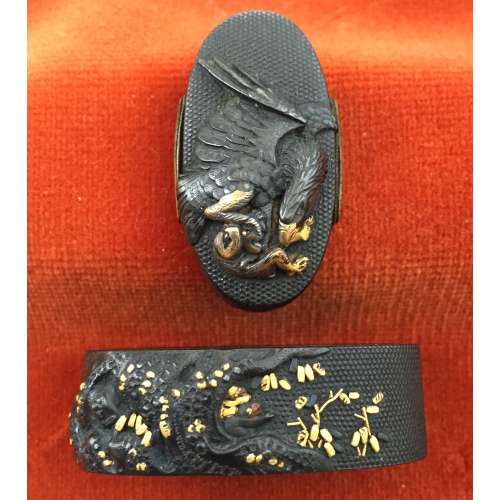 Fuchi: 38 x 22 x 12 mm. Kashira: 32 x 17 x 11 mm Main material: shakudo; surface treatment: nanako-ji; other metals: gold, shibuichi and copper; decorative technique: iroe takazogan. Signed: Nyudo Jounishi 人道 乗西 (possibly)
Fuchi: 38 x 22 x 12 mm. Kashira: 32 x 17 x 11 mm Main material: shakudo; surface treatment: nanako-ji; other metals: gold, shibuichi and copper; decorative technique: iroe takazogan. Signed: Nyudo Jounishi 人道 乗西 (possibly) -
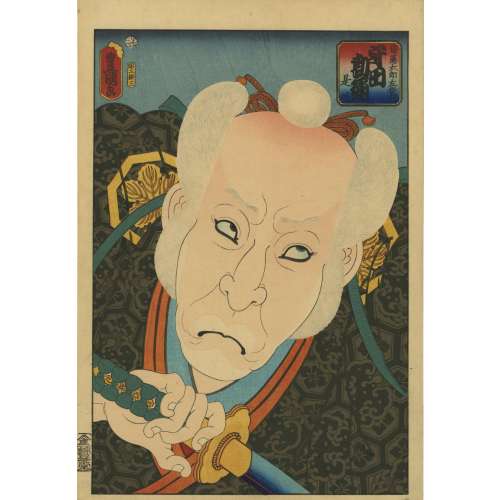 Artist: Utagawa Kunisada [歌川 国貞] a.k.a. Utagawa Toyokuni III [三代歌川豊国] (Japanese, 1786 – 1865). Block cutter: Horikō (Kiyomizu) Ryūzō [彫工 柳三]. Publisher: Ebisuya Shoshichi [恵比寿屋庄七], Kinshōdō (Japanese, fl. c. 1846 – 1883). Actor Morita Kan'ya XI as Saito Tarozaemon Toshiyuki (Morito Kan'ya, Saito Tarozaemon Toshiyuki) Signed Toyokuni ga within the artist's Toshidama cartouche, publisher's seal Sho, Kinshodo, carver's seal Horiko Ryusan, censor's seal aratame with date 1860, 3rd month. Date: 3/1860. Oban tate-e; 36.5 x 25.3 cm. The actor Morita Kan'ya XI (1802-1863) is in the role of Saito Tarozaemon Toshiyuki from the play Oto no Miya Asahi no Yoroi (Oto no Miyo and the Armor of the Rising Sun). The play picks up following the Genko War of 1331-33 in which Emperor Go-Daigo (1288-1339) led a failed uprising against the ruling Hojo clan. Tarozaemon was a Hojo warlord and is credited with much of the victory. After the conflict, his lord Norisada receives a summer festival lantern from the courtesan Sanmi-no-Tsubone, which bears a riddling inscription. He and Tarozaemon deliberate over the courtesan and her message for quite some time until they realize that she is attempting to manipulate Norisada in the hopes of returning the Emperor from exile. Following this revelation, Norisada reinterprets the message to mean kiriko, literally "to cut a child," and determines that Sanmi-no-Tsubone's son must be killed. He instructs Tarozaemon to do the deed. However, unbeknownst to Norisada and in spite of his allegiance to the Hojo clan, Tarozaemon is sympathetic to Sanmi-no-Tsubone and her son. At one time, his own daughter had served in the Imperial Palace and was spared execution only through Sanmi-no-Tsubone's intervention. As repayment of that debt, he kills his own grandson in the other boy's stead and returns to Norisada to report that he had accomplished the mission. This print is from a series of portraits that Kunisada undertook very late in life and has been named Kinshodo-ban yakusha okubi-e (Kinshodo's Large-Head Actor Portraits) in reference to the publisher, Ebisuya Shochochi of Kinshodo. The series depicted great actors from the past and present in their famous roles. Kunisada was guided by images from his own oeuvre: he recorded Kan'ya in this role in the 8th month of 1829. As this was meant to be Kunisada's grandest actor series, it was executed on thick paper with the best possible pigments and the highest level of craftsmanship. In this unusual frontal portrait, Kunisada presents Morita Kan'ya XI as the loyal Tarozaemon with his eyes rolling upward and his jaw set in grim determination to commit the unthinkable act in an ultimate display of samurai honour. Text by Scholten Japanese Art, New York. Ref.: Waseda University Theatre Museum (enpaku.waseda.ac.jp), accession no. 100-5261 (for 1829 portrait of the same); [LIB-1212.2017] Robert Schaap. Kunisada: Imaging, drama and beauty. — Leiden: Hotei Publishing, 2016, p. 165 (№ 16). Andreas Marks. Publishers of Japanese woodblock prints: A compendium. Ebisuya Shoshichi (1846-83) - P6032.
Artist: Utagawa Kunisada [歌川 国貞] a.k.a. Utagawa Toyokuni III [三代歌川豊国] (Japanese, 1786 – 1865). Block cutter: Horikō (Kiyomizu) Ryūzō [彫工 柳三]. Publisher: Ebisuya Shoshichi [恵比寿屋庄七], Kinshōdō (Japanese, fl. c. 1846 – 1883). Actor Morita Kan'ya XI as Saito Tarozaemon Toshiyuki (Morito Kan'ya, Saito Tarozaemon Toshiyuki) Signed Toyokuni ga within the artist's Toshidama cartouche, publisher's seal Sho, Kinshodo, carver's seal Horiko Ryusan, censor's seal aratame with date 1860, 3rd month. Date: 3/1860. Oban tate-e; 36.5 x 25.3 cm. The actor Morita Kan'ya XI (1802-1863) is in the role of Saito Tarozaemon Toshiyuki from the play Oto no Miya Asahi no Yoroi (Oto no Miyo and the Armor of the Rising Sun). The play picks up following the Genko War of 1331-33 in which Emperor Go-Daigo (1288-1339) led a failed uprising against the ruling Hojo clan. Tarozaemon was a Hojo warlord and is credited with much of the victory. After the conflict, his lord Norisada receives a summer festival lantern from the courtesan Sanmi-no-Tsubone, which bears a riddling inscription. He and Tarozaemon deliberate over the courtesan and her message for quite some time until they realize that she is attempting to manipulate Norisada in the hopes of returning the Emperor from exile. Following this revelation, Norisada reinterprets the message to mean kiriko, literally "to cut a child," and determines that Sanmi-no-Tsubone's son must be killed. He instructs Tarozaemon to do the deed. However, unbeknownst to Norisada and in spite of his allegiance to the Hojo clan, Tarozaemon is sympathetic to Sanmi-no-Tsubone and her son. At one time, his own daughter had served in the Imperial Palace and was spared execution only through Sanmi-no-Tsubone's intervention. As repayment of that debt, he kills his own grandson in the other boy's stead and returns to Norisada to report that he had accomplished the mission. This print is from a series of portraits that Kunisada undertook very late in life and has been named Kinshodo-ban yakusha okubi-e (Kinshodo's Large-Head Actor Portraits) in reference to the publisher, Ebisuya Shochochi of Kinshodo. The series depicted great actors from the past and present in their famous roles. Kunisada was guided by images from his own oeuvre: he recorded Kan'ya in this role in the 8th month of 1829. As this was meant to be Kunisada's grandest actor series, it was executed on thick paper with the best possible pigments and the highest level of craftsmanship. In this unusual frontal portrait, Kunisada presents Morita Kan'ya XI as the loyal Tarozaemon with his eyes rolling upward and his jaw set in grim determination to commit the unthinkable act in an ultimate display of samurai honour. Text by Scholten Japanese Art, New York. Ref.: Waseda University Theatre Museum (enpaku.waseda.ac.jp), accession no. 100-5261 (for 1829 portrait of the same); [LIB-1212.2017] Robert Schaap. Kunisada: Imaging, drama and beauty. — Leiden: Hotei Publishing, 2016, p. 165 (№ 16). Andreas Marks. Publishers of Japanese woodblock prints: A compendium. Ebisuya Shoshichi (1846-83) - P6032. -
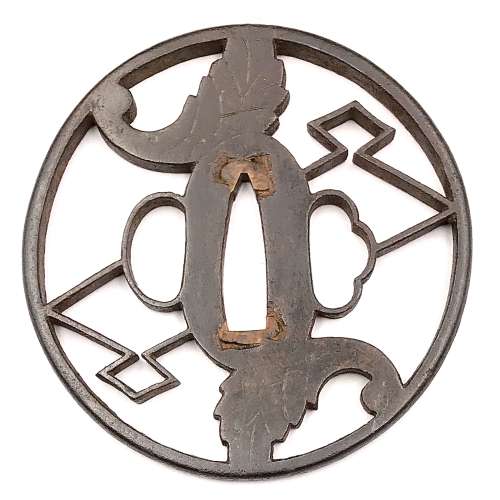 Iron tsuba of round form with design of ginger and double diamonds (myoga-ni-nigaibishi) in openwork (sukashi), details carved in kebori technique. Slightly rounded square rim. Copper sekigane. Shoami school. Early Edo period: Late 17th century (Kanbun/Enppo era). Height: 80.1 mm. Width: 79.8 mm. Rim thickness: 5.0 mm. Center thickness: 4.7 mm. Provenance: Sasano Masayuki Collection, № 110.
Iron tsuba of round form with design of ginger and double diamonds (myoga-ni-nigaibishi) in openwork (sukashi), details carved in kebori technique. Slightly rounded square rim. Copper sekigane. Shoami school. Early Edo period: Late 17th century (Kanbun/Enppo era). Height: 80.1 mm. Width: 79.8 mm. Rim thickness: 5.0 mm. Center thickness: 4.7 mm. Provenance: Sasano Masayuki Collection, № 110. -
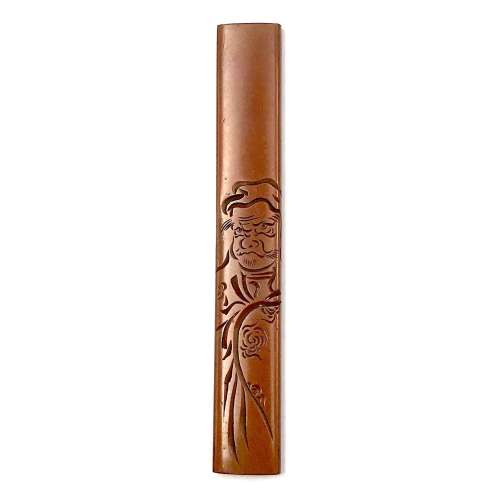 Kozuka made of pure copper with Daruma motif. The engraving technique is known as katakibori ("half-cut carving"). Signed on the back: Yasuchika. Size: 96.5 (H) x 14.5 mm (W). Edo period (Late 18th century). The technique of Katakiribori was developed by Yokoya school of artisans. Detailed account of Yasuchika family of kodōgo carvers is given at Japanese Sword Fittings from the Alexander G. Mosle Collection; Sebastian Izzard LLC, 2004 on page 64. The article ends with the following statement: "Given the popularity of his style and his many students, it is not surprising that a number of works bearing Yasuchika's signature are today disputed." S. Izzard attributes Yasuchika masters to Nara school. Yasuchika-signed kozuka in Important Japanese Swords and Sword Furniture and Works of Art [November 5, 1980, sales "Kotetsu". New York, Christie, Manson & Woods International Inc., 1980, pp.92-93, lot 172 and 173] are stylistically very different to our example. A shibuichi katakiribori kozuka, bearing the signature of Yashuchika, is illustrated at The Hartman Collection of Japanese Metalwork [sold at auction by Christie, Manson & Woods Ltd. June 30 and July 1, London, 1976] on page 82, lot 291. It depicts Daikoku and stylistically similar to ours. The description on page 83 says: "signed Yasuchika, and inscribed "drawn by Hanabusa Itcho" (Yasuchika IV, school of Iawamoto konkan, circa 1800)". A detailed account of Yasuchika signatures is presented at Masterpiece tsuba and kodogu from the Hans Conried and Alexander G. Mosle collections. Important woodblock prints by Utamaro, Hokusai, Hiroshige, Yoshida and other masters. San Francisco, September 1-25, 1983. Catalog #7. Robert E. Haynes, Ltd., pp. 141-174. The example that looks like ours is on page 146:
Kozuka made of pure copper with Daruma motif. The engraving technique is known as katakibori ("half-cut carving"). Signed on the back: Yasuchika. Size: 96.5 (H) x 14.5 mm (W). Edo period (Late 18th century). The technique of Katakiribori was developed by Yokoya school of artisans. Detailed account of Yasuchika family of kodōgo carvers is given at Japanese Sword Fittings from the Alexander G. Mosle Collection; Sebastian Izzard LLC, 2004 on page 64. The article ends with the following statement: "Given the popularity of his style and his many students, it is not surprising that a number of works bearing Yasuchika's signature are today disputed." S. Izzard attributes Yasuchika masters to Nara school. Yasuchika-signed kozuka in Important Japanese Swords and Sword Furniture and Works of Art [November 5, 1980, sales "Kotetsu". New York, Christie, Manson & Woods International Inc., 1980, pp.92-93, lot 172 and 173] are stylistically very different to our example. A shibuichi katakiribori kozuka, bearing the signature of Yashuchika, is illustrated at The Hartman Collection of Japanese Metalwork [sold at auction by Christie, Manson & Woods Ltd. June 30 and July 1, London, 1976] on page 82, lot 291. It depicts Daikoku and stylistically similar to ours. The description on page 83 says: "signed Yasuchika, and inscribed "drawn by Hanabusa Itcho" (Yasuchika IV, school of Iawamoto konkan, circa 1800)". A detailed account of Yasuchika signatures is presented at Masterpiece tsuba and kodogu from the Hans Conried and Alexander G. Mosle collections. Important woodblock prints by Utamaro, Hokusai, Hiroshige, Yoshida and other masters. San Francisco, September 1-25, 1983. Catalog #7. Robert E. Haynes, Ltd., pp. 141-174. The example that looks like ours is on page 146:
 Though we have to admit that the example from Catalog #7 by Robert E. Haynes looks much stronger.
Though we have to admit that the example from Catalog #7 by Robert E. Haynes looks much stronger.
-
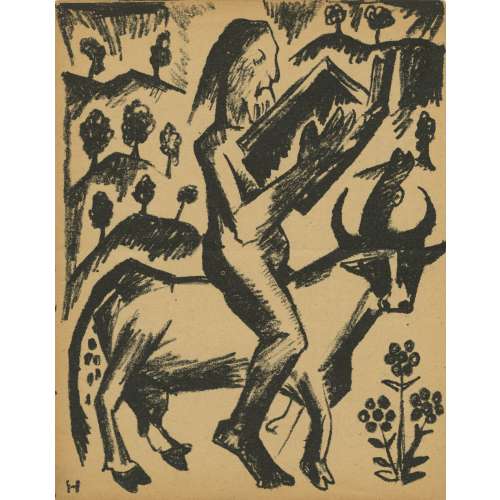 Artist: Natalia Goncharova (July 3, 1881 – October 17, 1962). Russian/French. Lithographic illustration "An elder astride a bull" for Aleksei Kruchenykh book "Two poems. The Hermit. The Hermitess", Moscow, Kuzmin and Dolinsky Publishers, 1913. This sheet is from the book "Natalia Goncharova / Mikhail Larionov" by Eli Eganbyuri (pen-name of Ilia Zdanevich), published by Z. A. Münster in 1913. Inscription on the back: hand-written copy (allegedly by the hand of Osip Brik) of Vladimir Mayakovsky verses for "Red Pepper" (Krasny peretz) magazine issue of 1924, included in the compilation "Ferocious laugh" (Grozny smekh) that was published after Mayakovsky death in 1931. Text of the manuscript on verso. Size: 18,5 х 14,3 cm. Наталия Гончарова (3 июля 1881 – 17 октября 1962). Россия/Франция. Автолитография "Старец верхом на быке" для книги А. Е. Крученых "Две поэмы. Пустынники. Пустынница"; - М.: Изд. Г.Л. Кузьмина, С.Д. Долинского, 1913. Данный лист из книги Эли Эганбюри (псевдоним Ильи Зданевича) "Наталия Гончарова / Михаил Ларионов"; - М. : Изд. Ц. Мюнстера, 1913. На обороте список стихов из подписей к "Красному перцу" 1924 г., которые вошли в сб. "Грозный смех" (вышел после смерти Маяковского в 1931). Вероятно список сделан рукой Осипа Брика. Текст манускрипта. Формат: 18,5 х 14,3 см.
Artist: Natalia Goncharova (July 3, 1881 – October 17, 1962). Russian/French. Lithographic illustration "An elder astride a bull" for Aleksei Kruchenykh book "Two poems. The Hermit. The Hermitess", Moscow, Kuzmin and Dolinsky Publishers, 1913. This sheet is from the book "Natalia Goncharova / Mikhail Larionov" by Eli Eganbyuri (pen-name of Ilia Zdanevich), published by Z. A. Münster in 1913. Inscription on the back: hand-written copy (allegedly by the hand of Osip Brik) of Vladimir Mayakovsky verses for "Red Pepper" (Krasny peretz) magazine issue of 1924, included in the compilation "Ferocious laugh" (Grozny smekh) that was published after Mayakovsky death in 1931. Text of the manuscript on verso. Size: 18,5 х 14,3 cm. Наталия Гончарова (3 июля 1881 – 17 октября 1962). Россия/Франция. Автолитография "Старец верхом на быке" для книги А. Е. Крученых "Две поэмы. Пустынники. Пустынница"; - М.: Изд. Г.Л. Кузьмина, С.Д. Долинского, 1913. Данный лист из книги Эли Эганбюри (псевдоним Ильи Зданевича) "Наталия Гончарова / Михаил Ларионов"; - М. : Изд. Ц. Мюнстера, 1913. На обороте список стихов из подписей к "Красному перцу" 1924 г., которые вошли в сб. "Грозный смех" (вышел после смерти Маяковского в 1931). Вероятно список сделан рукой Осипа Брика. Текст манускрипта. Формат: 18,5 х 14,3 см.Г. Л. Кузьмин и С. Д. Долинский знамениты, в частности, тем, что в 1912 году издали футуристский манифест "Пощечина общественному вкусу". О них можно найти дополнительную информацию в статье об Л. Л. Кузьмине. Издатель Цезарь Александрович Мюнстер был сыном знаменитого русского литографа Александра Эрнестовича Мюнстера, открывшего свое литографическое заведение в Санкт-Петербурге в 1850 году. Судьба Ц. А. Мюнстера и его издательства после революции 1917 года мне неизвестна.
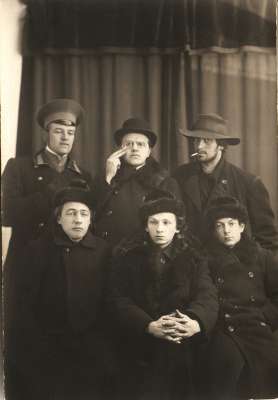
Сидят: В.В. Хлебников, Г.Л. Кузьмин, С.Д. Долинский Стоят: Н.Д. Бурлюк, Д.Д. Бурлюк, В.В. Маяковский. 1911.
-
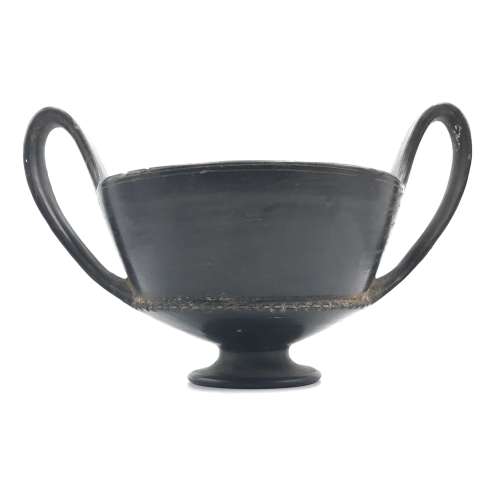 Etruscan Bucchero Pottery Kantharos, ca. 758-264 BC. A ceramic vessel with high handles, meant for consuming wine. Flanged border between the body and the foot displays dozens of incised grooves. The rim is smooth, and the upper and of each handle flows seamlessly into the body if the vessel. Bucchero is an Etruscan type of pottery named for the specific firing technique which results in a smooth, shiny black finish. Size: 21.6 x 13.3 cm. Portions os both handles repaired with some overpainting and light adhesive residue along break lines, One handle stabilized with some new material and overpainting along fissure line. Light earthen deposits within recessed areas.
Etruscan Bucchero Pottery Kantharos, ca. 758-264 BC. A ceramic vessel with high handles, meant for consuming wine. Flanged border between the body and the foot displays dozens of incised grooves. The rim is smooth, and the upper and of each handle flows seamlessly into the body if the vessel. Bucchero is an Etruscan type of pottery named for the specific firing technique which results in a smooth, shiny black finish. Size: 21.6 x 13.3 cm. Portions os both handles repaired with some overpainting and light adhesive residue along break lines, One handle stabilized with some new material and overpainting along fissure line. Light earthen deposits within recessed areas.



